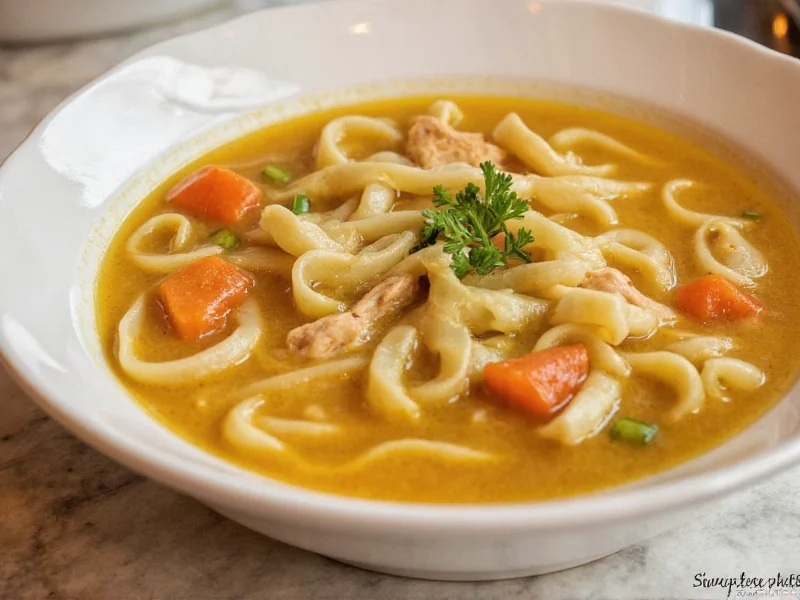Chicken noodle soup stands as one of the most beloved comfort foods worldwide, offering both nourishment and emotional comfort. Whether you're fighting a cold or simply craving a warm, satisfying meal, mastering this classic recipe brings culinary satisfaction and practical benefits. The magic happens when simple ingredients transform through careful preparation into something far greater than the sum of its parts.
The Essential Components of Perfect Chicken Noodle Soup
Creating exceptional chicken noodle soup requires understanding its fundamental elements. The broth forms the foundation—rich, flavorful, and properly seasoned. Many home cooks make the mistake of using store-bought broth without enhancing it, resulting in flat-tasting soup. For authentic depth, start with a homemade stock or significantly boost store-bought versions with additional aromatics and herbs.
Fresh vegetables provide texture and nutritional value. The classic mirepoix of carrots, celery, and onions creates the flavor base, while additional vegetables like leeks or parsnips can add complexity. The chicken should be tender but not overcooked—poaching bone-in pieces yields better flavor than using pre-cooked shredded chicken. Finally, the noodles must be cooked separately and added just before serving to prevent them from becoming mushy.
Classic Homemade Chicken Noodle Soup Recipe
This traditional recipe yields approximately 8 servings and requires about 3 hours total time, with 45 minutes of active preparation. The extended simmering time extracts maximum flavor from the bones while creating a rich, gelatinous broth that's both comforting and nutritious.
Ingredients
- 3-4 pounds chicken bones and carcass (or 2 whole chicken legs and 2 breasts with bones)
- 2 tablespoons olive oil
- 1 large onion, quartered
- 3 carrots, peeled and chopped
- 3 celery stalks, chopped
- 3 garlic cloves, smashed
- 1 parsnip, peeled and chopped (optional)
- 8 cups cold water
- 2 bay leaves
- 1 teaspoon whole black peppercorns
- Small bunch fresh parsley
- 1 teaspoon salt (adjust to taste)
- 8 ounces egg noodles
- Fresh dill or parsley for garnish
Step-by-Step Preparation
- Prepare the broth: In a large stockpot, heat olive oil over medium heat. Add chicken bones and brown lightly on all sides. Remove and set aside.
- Sauté vegetables: In the same pot, add onions, carrots, celery, and parsnip if using. Cook until softened, about 8 minutes. Add garlic and cook 1 minute more.
- Simmer: Return chicken bones to pot. Add cold water, bay leaves, peppercorns, and half the parsley. Bring to a gentle boil, then reduce heat to low. Skim any foam that rises to the surface.
- Cook slowly: Partially cover and simmer for 2-3 hours. Do not boil vigorously, as this will make the broth cloudy.
- Strain and prepare chicken: Remove bones and large vegetable pieces. Strain broth through a fine-mesh sieve. If using whole chicken pieces, remove meat from bones, shred, and return to broth.
- Final assembly: Bring broth back to a simmer. Add salt to taste. Cook noodles separately according to package directions, then add to soup just before serving to prevent overcooking.
| Component | Key Considerations | Common Mistakes |
|---|---|---|
| Broth | Simmer gently for 2-3 hours; skim foam regularly | Boiling too vigorously; not skimming impurities |
| Vegetables | Add root vegetables early, delicate ones later | Overcooking vegetables until mushy |
| Noodles | Cook separately and add just before serving | Boiling noodles directly in soup causing starchiness |
| Seasoning | Season in layers; adjust final salt after reducing | Adding all salt at beginning resulting in oversalting |
Helpful Variations for Different Needs
While the classic recipe satisfies most cravings, these variations address specific dietary needs and time constraints without sacrificing flavor:
Quick 30-Minute Chicken Noodle Soup
For those pressed for time, use high-quality store-bought broth as your base. Sauté vegetables as in the classic recipe, then add 6 cups of broth, 2 cups shredded cooked chicken, and simmer for 15 minutes. Cook noodles separately and add at the end. Boost flavor with a splash of white wine during vegetable sautéing and a Parmesan rind simmered in the broth.
Slow Cooker Chicken Noodle Soup
Combine chicken bones, vegetables, herbs, and 8 cups water in a slow cooker. Cook on low for 6-8 hours. Strain broth, then return to slow cooker with shredded chicken and simmer 20 minutes. Add cooked noodles just before serving. This method extracts maximum flavor with minimal attention required.
Gluten-Free Chicken Noodle Soup
Substitute traditional egg noodles with gluten-free alternatives like rice noodles or quinoa pasta. Add them during the last 5-7 minutes of cooking to prevent disintegration. For extra nutrition, try spiralized zucchini or sweet potato "noodles" added in the final minutes of cooking.
Avoiding Common Chicken Noodle Soup Mistakes
Even experienced cooks make these preventable errors that diminish the final product:
- Overcooking noodles in the soup: Noodles continue absorbing liquid even after cooking. Always cook them separately and add just before serving.
- Adding salt too early: As liquid reduces, salt concentration increases. Season in stages, with final adjustments made after reduction.
- Boiling broth vigorously: A gentle simmer extracts flavor without making the broth cloudy or bitter.
- Skipping the skimming step: Removing foam during initial simmering results in a cleaner-tasting, clearer broth.
- Using only breast meat: Dark meat and bones contribute essential gelatin and flavor compounds that white meat alone cannot provide.
Storage and Reheating for Maximum Freshness
Proper storage maintains quality when making chicken noodle soup ahead of time. Always store noodles separately from broth to prevent them from becoming soggy. The broth and solid ingredients can be refrigerated for up to 4 days or frozen for 3 months.
When reheating, gently warm the broth mixture first, then add the noodles. If the soup has thickened during storage, add a splash of water or additional broth to reach desired consistency. Never boil reheated soup vigorously, as this can make the chicken tough and vegetables mushy.











 浙公网安备
33010002000092号
浙公网安备
33010002000092号 浙B2-20120091-4
浙B2-20120091-4